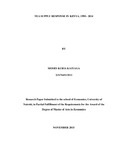| dc.description.abstract | The Tea sector is one of the fourteen priority sectors identified in the National Export Strategy
(NES). This strategy aims at improving Kenya's overall tea performance by creating new and
expanding existing export markets as well as promoting local consumption through diversifying
the export base, enhancing market access and strengthening institutional support networks and
increasing effectiveness. Despite the establishment of this strategy the supply of tea has been
volatile. Therefore, this paper sought to explore tea supply response in Kenya. The study used
time series data collected for the period 1990 to 2014 with the following study variables; tea
supply, tea prices, input prices, real exchange rate, wage rate, price of milk and dummy variable
representing weather pattern. The study employed dynamic Nerlovian model and conducted preand post-estimation tests. At 1%, 5% and 10% significance levels; the first difference of the first
difference of the tea prices, the first difference of the input prices, the first difference of the wage
rates and the first difference of real exchange rates were found to be statistically significant in
determining the current quantity of tea supplied in Kenya. However, the first difference of milk
prices and the weather patterns were found to be statistically insignificant in determining the
quantity of tea supplied in Kenya. On the other hand, it was shown that the first differences of
input prices and the first difference of real exchange rates significantly reduce the current
quantity of tea supply while the first differences of tea prices and wage rate were shown to be
statistically significant in increasing the current quantity of tea supply in Kenya. The study
suggests that as a developing country, which intends to be a dominant supplier, the government
should give special attention to tea pricing policies which are major impediment to increased
production in the agricultural sector and seek for both regional and international markets in
addition to offering farmers incentives through input subsidies of the important inputs like
fertilizers which go into the production process as well as seeking for new markets for tea.
Further, the study recommends a review of the wage policies by KTDA to adjust wage rates to
reasonable rates as a motivation towards increased tea supply in Kenya while adjusting the real
exchange rates to stabilize overall tea prices. | en_US |

